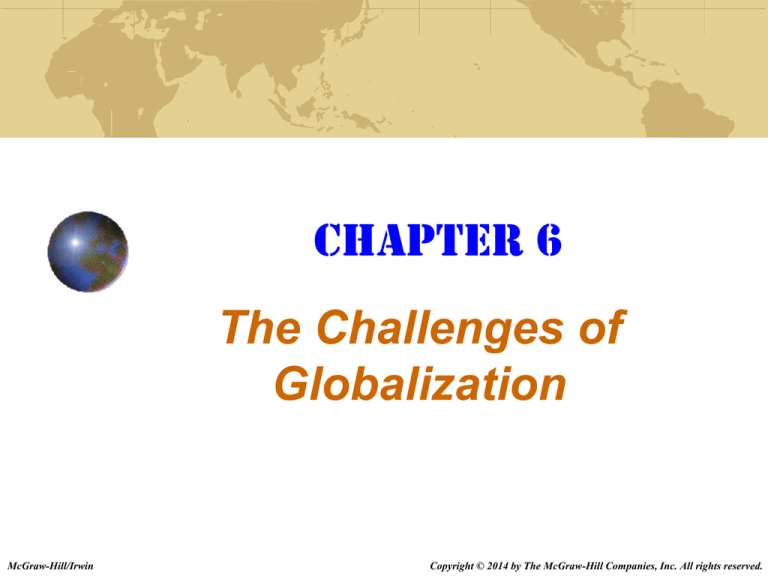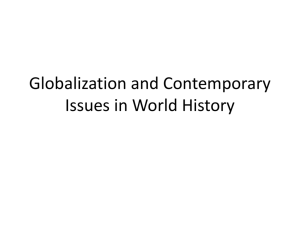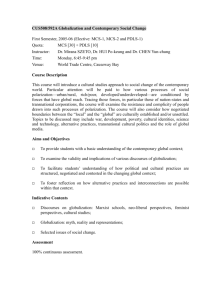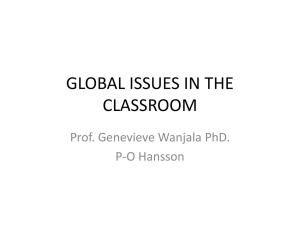
Chapter 6
The Challenges of
Globalization
McGraw-Hill/Irwin
Copyright © 2014 by The McGraw-Hill Companies, Inc. All rights reserved.
Ch. 6 Key Learning Objectives
Defining globalization and classifying the major ways in
which companies enter the global marketplace
Recognizing the major drivers of the globalization process
and the international financial and trade institutions that have
shaped this process in recent decades
Analyzing the benefits and costs of the globalization of
business
Identifying the major types of political and economic systems
in which companies operate across the world, and the
special challenges posed by doing business in diverse
settings
Assessing how businesses can work collaboratively with
governments and the civil sector to address global social
issues
6-2
The Process of Globalization
Refers to the increasing movement of goods,
services, and capital across national borders
Is considered a process – an ongoing series of
interrelated events
International trade and financial flows integrate the world
economy, leading to the spread of technology, culture, and
politics
Globalization is not simply a trend or a fad but, rather, an
international system
6-3
Entering and Competing in the
Global Marketplace
Develop global market channels
First build a successful business in their home country, then
export products or services to buyers in other countries
Establish global operations
Locate manufacturing plants or service operations in other
countries as a way to cut costs
Develop global supply chains
Purchase raw materials, components, or other supplies from
sellers in other countries; work may also be subcontracted
6-4
Major Transnational Corporations (TNCs)
Defined by the United Nations as firms that control assets
abroad
104,000 TNCs operate in the modern global economy
They, in turn, have nine times that number of affiliates (suppliers,
subcontractors, and other entities with which they have some
business relationship)
Most global commerce is carried out by a small number of
powerful firms
Next slide lists top 10 non-financial transnational corporations,
ranked in order of the value of the foreign assets they control
6-5
Figure 6.1 The World’s Top 10 Nonfinancial
Transnational Corporations
6-6
Foreign Direct Investment
Another important aspect of globalization is the
worldwide flow of capital
Foreign direct investment (FDI) occurs when a company,
individual, or fund invests money in another country, for
example, by buying shares of stock in or loaning money
to a foreign firm
In 2010, FDI was $1.24 trillion
6-7
The Acceleration of Globalization
The world’s economy is becoming increasingly
integrated
Higher share of output is being exported across national borders
One-fifth of all goods and services produced worldwide is sold to
other nations, rather than domestically
This is almost double the percentage of 1960
In earlier years, most exports were of goods. An
important recent trend is the globalization of services,
such as travel, insurance, financial, and information
services.
6-8
The Acceleration of Globalization
Driven by several factors:
Technological innovation
• Easier to communicate with employees, partners, and suppliers
all over the globe in real time
Transportation systems
• Improvements enable the fast and cheap movement of goods
and services from one place to another
The rise of major transnational corporations
• Bigger, well-capitalized, firms are better equipped to conduct
business across national boundaries than smaller firms
Social and political reforms
• Rise of Pacific Rim growth economies, collapse of communism
in Central and Eastern Europe have opened new regions to
world trade
6-9
International Financial
and Trade Institutions
Three institutions that set the rules by which international
commerce is transacted:
World Bank (WB)
International Monetary Fund (IMF)
World Trade Organization (WTO)
No business can operate across national boundaries
without complying with rules set by the WTO
Many businesses in developing countries are dependent
on WB and IMF loans to survive
6-10
The World Bank
Established in 1944
Provides economic development loans to its member
nations
Funds used mainly for roads, dams, power plants,
pipelines, and other infrastructure projects
Funding provided by member countries and
international capital markets
Negotiates “structural adjustment plans” with
countries it loans to
Applies conditions on these countries
Conditions are considered by critics to lead to unfair burden
on developing countries
6-11
International Monetary Fund
“Sister” organization to World Bank, created at same
time
Purpose is to make currency exchange easier for
member countries so that they can participate in global
trade
Lends foreign exchange to member countries
Imposes conditions on governments that receive its
loans
Has begun to offer debt relief to some nations
6-12
World Trade Organization
Founded in 1995, successor to General Agreement on
Tariffs and Trade (GATT)
International body that establishes the ground rules for
trade among nations
Its major objective is to promote free trade; attempts to
eliminate barriers to trade (e.g. quotas, duties and tariffs)
Conducts “rounds” of negotiations on various topics
“Most favored nation” rule means members countries
cannot discriminate against foreign products for any reason
6-13
The Benefits and
Costs of Globalization
Globalization is highly controversial
Clearly, some benefit from globalization, while others do
not
What are some of the major arguments advanced by both side in
the debate over this important issue?
6-14
Figure 6.2 Benefits and Costs of Globalization
6-15
Comparative Political
and Economic Systems
Nations differ greatly in their political, social and
economic systems
First important dimension to consider is how power is
exercised and degree of democratic rights
Past century has been marked by spread of democratic
rights to many nations for the first time
6-16
Comparative Political Systems
Democracy – The presence of political freedom
Four defining features of democracy (according to
the U.N.)
Fair elections
An independent media
Separation of powers among the executive, legislative, and
judicial branches of government
An open society where citizens have the right to form their
own independent organizations to pursue social, religious,
and cultural goals
6-17
Comparative Political Systems
Military dictatorships
Repressive regimes ruled by dictators who exercise total
power through control of the armed forces
Examples include Zimbabwe and Uzbekistan
Rights of citizens to organize for cultural or religious
freedoms is restricted in others
Examples include Iran, Saudi Arabia
According to United Nations estimates, 106 countries still
limit important civil and political freedoms
6-18
Comparative Political Systems
Degree to which human rights are protected differs
greatly among nations
Several international codes of human rights exist
Most important one is United Nations Universal Declaration of
Human Rights of 1948
Over half world’s nations have adopted these human rights
covenants
Still, many violations of human rights still occur:
Recent genocides in Rwanda, Sudan
Systems where minority groups and indigenous peoples lack
basic human rights, example of Nepal
6-19
Comparative Economic Systems
Free enterprise systems
Based on the principle of voluntary association and
exchange
Members of society satisfy most of their economic needs
through voluntary market transactions
Central state control
Economic power is concentrated in the hands of government
officials and political authorities
The central government owns the property that is used to
produce goods and services
6-20
Challenges of Global Diversity
Diversity and complexity of systems that
transnational corporations face creates challenges
If a company does business in a nation that does not grant
women equal rights, should that company hire and promote
women at work, even if it violates local laws and customs?
Should a company enter into a business venture with a
government-owned enterprise if that government has a
reputation for violating its citizens’ human rights?
6-21
Meeting the Challenges
of Global Diversity
Notion of constructive engagement
By operating with strong moral principles, transnational
corporations can be a force for positive change in nations
where they operate
In some circumstances this is not possible due to
extreme conditions, provoking dilemma
At what point do violations of political, human, and economic
rights become so extreme that a company cannot morally
justify doing business in that country?
6-22
Collaborative Partnerships for
Global Problem Solving
Emerging trend for development of collaborative, multisector partnerships focused on particular social issues
or problems in the global economy
These partnerships have been termed global action
networks, or GANs
Involves 3 sectors
Business
Government
Civil society
Unique capabilities of each sector is presented on
following slide
6-23
Figure 6.3 Distinctive Attributes of the
Three Major Sectors
6-24




